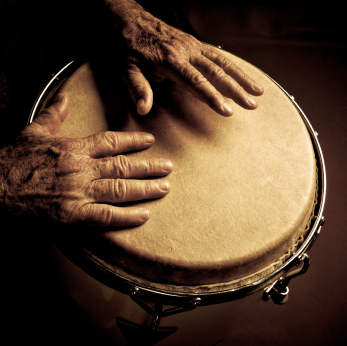Home Frank’s Blog Music and the Brain: Rhythm & Playing
Music and the Brain: Rhythm & Playing
Frank Fitzpatrick 09/20/2012

|
No time to read? Pick your language & press PLAY
Getting your Trinity Audio player ready...
|
WHY MUSIC – Part 2B – Music and the Brain: Rhythm and Playing
“Music is a moral law. It gives soul to the universe, wings to the mind, flight to the imagination, and charm and gaiety to life and to everything.” – Plato
Behind the Beat
 The oldest known musical instrument, other than the voice, is the drum. Man’s use of the drum since the dawning of civilization may help explain why our brain is so innately attuned to respond to rhythm. Music with a steady beat serves as an auditory control mechanism for organizing all kinds of thought and movement – from opening the door to remembering where you left your keys.
The oldest known musical instrument, other than the voice, is the drum. Man’s use of the drum since the dawning of civilization may help explain why our brain is so innately attuned to respond to rhythm. Music with a steady beat serves as an auditory control mechanism for organizing all kinds of thought and movement – from opening the door to remembering where you left your keys.
Rhythm itself has served as a primary source of communication throughout certain periods of history. This can be witnessed in the message-encoded drumming between African slaves, with the role of military drummers on the battlefield, and through one of the earliest forms of electronic communication – Morse code. The human brain is wired to recognize and organize our thoughts into rhythmic patterns.
Our systems naturally entrain to the pulse of the music. From our early days in the womb when our inner rhythm entrained to the beat of our mother’s heart, to the countless times we moved and sang along to our favorite song, to those nights in the club dancing to a steady beat with 1000 strangers – our nervous system, our brain and our metabolism were being programmed by the rhythm.
Unlike visual stimuli, music has a remarkable ability to drive rhythmic, metrically organized motor behavior. This is why it is much easier to tap along in accurate time to an audible beat, than to a flashing image or light.
Playing Music
 In addition to engaging nearly all the parts of our brain required for active listening (see Music and the Brain Part A: Active Listening), physically playing a rhythm, or any instrument for that matter, helps us create a complex neuro-feedback loop between the auditory cortex and the motor cortex that controls the movements of our bodies. When a musician performs, at least three basic motor control functions are required: timing, sequencing and spatial organization of movement.
In addition to engaging nearly all the parts of our brain required for active listening (see Music and the Brain Part A: Active Listening), physically playing a rhythm, or any instrument for that matter, helps us create a complex neuro-feedback loop between the auditory cortex and the motor cortex that controls the movements of our bodies. When a musician performs, at least three basic motor control functions are required: timing, sequencing and spatial organization of movement.
The Musician’s Brain
New developments in neuroscience and technology such as FMRI, are unveiling new discoveries every week and reaffirming theories that many scientists, philosophers and musicologists have held for centuries. It appears that highly trained and proficient musicians may even have different brain structures than the rest of us, especially those that started training as children. Recent studies show that long-term musical training and expert level performance are associated with enhanced features of the brain’s actual anatomy in both auditory and motor regions.
It is especially inspiring that the insights gained from scientists and doctors studying these processes are being applied to groundbreaking treatments for people suffering from autism, ADHD and Parkinson’s disease, as well as being used to help with stroke rehab and other learning disorders.
Whether you are a professional musician or a beginner, a therapist or a parent, it is important to realize that playing music can engage more areas of the human brain than any other known human activity. In addition to acting as a mega-vitamin for a healthier brain, playing music can enhance your and your loved ones’ overall well being and quality of life.
Benefits of Playing Music
 The benefits of playing music could fill several books, but here are a few key points that might encourage you to dust off that favorite old instrument and enjoy a little time communing with music, to support music education programs – starting with ones for your own children, or to begin taking those lessons you have been promising yourself for years. Playing music can contribute to:
The benefits of playing music could fill several books, but here are a few key points that might encourage you to dust off that favorite old instrument and enjoy a little time communing with music, to support music education programs – starting with ones for your own children, or to begin taking those lessons you have been promising yourself for years. Playing music can contribute to:
• Refined motor control skills
• Greater ability to focus
• Increased sense of balance and relaxation
• Stronger pattern recognition
• Improved spacial organization
• Better memory of sequential movements
• Stimulate multiple areas of the brain
• Enhanced cognitive abilities
• Improved verbal intelligence & executive function
• New treatments for neurodevelopmental disabilities
Playing for Inner Peace
I find playing music to be one of my strongest personal therapies, not only from the state of being I can achieve while playing, but also from the energetic balancing and mood enhancing effect on my mind, body and spirit throughout the day. Playing with other musicians and for appreciative audiences has become one of my most fulfilling ways to connect to and reap the benefits of community. I have even come to include my instruments as an integral part of my spiritual practice, starting by interweaving my guitar playing and singing voice into my morning meditations.
View this article on Huffington Post.
To view the full Why Music series click here.
I’m here to help YOU create a better world, inside and out.
Contact Me© 2025 Frank Fitzpatrick Website by AllHereIndia














